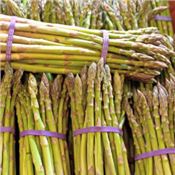Recipe Page
Asparagus-Tender, Tasty Spears

CARLA DUE
TEXARKANA, ARKANSAS
Asparagus plants are perennial vegetables that produce tasty, tender spears year after year. If you have ever wondered why asparagus is so expensive, consider that it takes asparagus approximately two to three years from seed to harvest to your table. While it is slow to mature into a crop producing vegetable, an asparagus plant can last up to roughly 20 years!
When is asparagus in season?
Asparagus is available from February through June, but we also have access to hot house varieties in local supermarkets. When buying, look for closed, compact tips, smooth, round spears, and a fresh appearance. A rich green color should cover most of the spear. Stalks should be tender almost as far down as the green extends. Over mature asparagus is tough and has a poor flavor. Avoid excessively sandy asparagus. The sand grains can lodge beneath the scales or in the tips of the spears which will make it difficult to remove in washing.
What's the difference between green and white asparagus?
Green and white asparagus come from the same plant. Green asparagus gets its color from sunlight. When the plant breaks through the ground, the sun hits it, turning it green. For white asparagus, sunlight is prevented from touching the plant by piling dirt on top of the stalks, so the asparagus matures underground. Once the tip breaks through the surface, the stalk is cut with a special knife beneath the ground. Green asparagus tends to have higher levels of nutrients, such as protein, as well as ascorbic acid, calcium, thiamin, and niacin.
White asparagus generally has lower antioxidant content than green spears. White asparagus has a milder flavor and is preferred in gourmet cuisine.
Storing and Prepping Tips
Once harvested, asparagus loses quality very rapidly. The sugar content declines and the amount of fibrous material increases. Use spears with compact heads; those with loose heads are fibrous and do not keep well.
Due to its delicate nature, asparagus should be cooked the same day it is purchased. If you wish to keep it longer, it should be kept cold and covered. Trim the stem end about one fourth inch and wash in warm water several times. Pat dry and place in moisture proof wrapping and store in the crisper drawer of the refrigerator. Refrigerate and use within 2 to 3 days for best quality, but no longer than a week. To maintain freshness, wrap a moist paper towel around the stem ends, or stand upright in two inches of cold water.
Is there any way to make the asparagus keep longer?
For longer storage, blanch small asparagus spears 2 minutes, medium 3 minutes, and large 4 minutes. Cool promptly, drain and package, leaving no head space. Seal and freeze.
This veggie is high in folic acid and a good source of potassium, fiber, thiamin, and vitamins A, B6, and C. For asparagus, a standard serving size is one half cup of pieces or 6 medium spears. For only 20 calories, you get a lot of nutrients!
Cooking Tips
The secret to maintaining all these valuable nutrients and flavor is to not overcook the vegetable. Overcooking will leave you with a mushy or watery product. When cooking fresh asparagus on the stovetop, place trimmed and washed asparagus, standing on stem, in a saucepan with one- half inch of water. Boil, cooking uncovered for the first three minutes, then cover and cook to the crisp tender stage. Remove with tongs. A squeeze of lemon juice will bring out the delicate flavor without adding calories or fat.
Oven Roasted Asparagus makes a quick vegetable to go with your dinner meal. To remove woody ends, grab stalk of the asparagus at stem end and bend until it snaps. It will naturally snap where it starts to get tough.
Oven Roasted Asparagus Recipe
1 bunch thin asparagus spears, trimmed
2-3 tablespoons olive oil
1 1/2 tablespoons grated Parmesan cheese
1 clove garlic, minced
1/2 to 1 teaspoon salt
1/2 teaspoon ground black pepper
1 tablespoon lemon juice
Preheat oven to 425 degrees F.
Place the asparagus into a mixing bowl, and drizzle with olive oil.
Toss to coat the spears. In a small bowl combine garlic, salt, and pepper.
Sprinkle garlic mixture over asparagus.
Arrange the asparagus onto a baking sheet lined with parchment paper or aluminum foil, in a single layer.
Sprinkle with parmesan cheese.
Bake in the preheated oven until just tender, 12 to 15 minutes depending on thickness. Sprinkle with lemon juice just before serving. ∆
CARLA DUE: U of A System Division of Agriculture